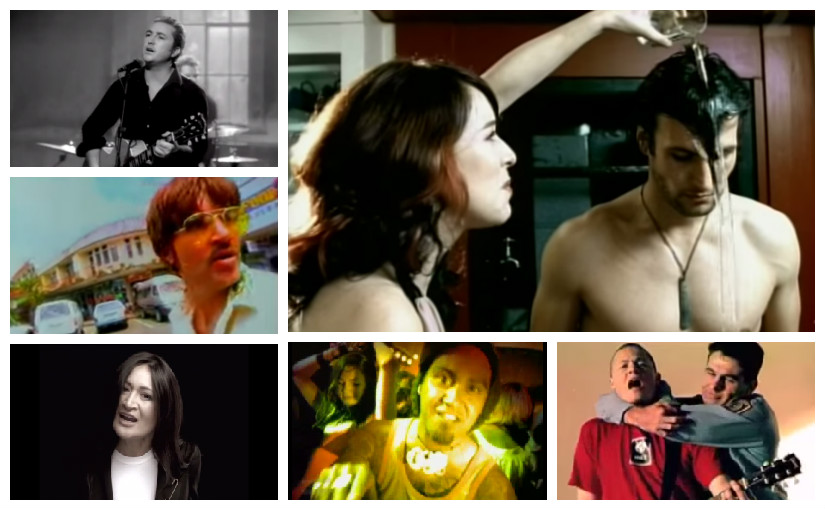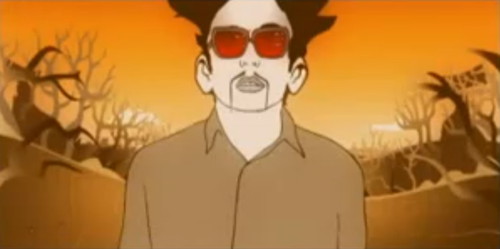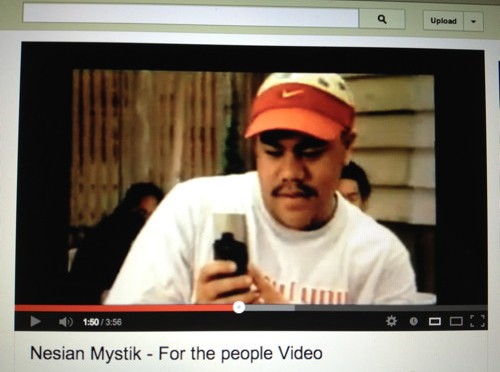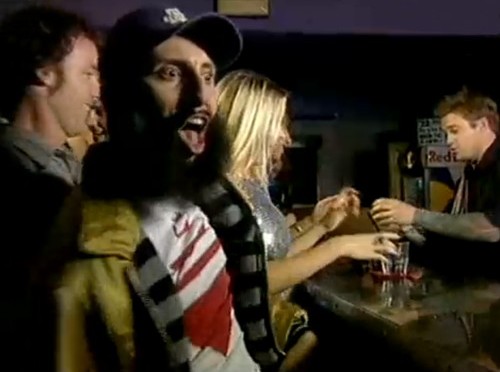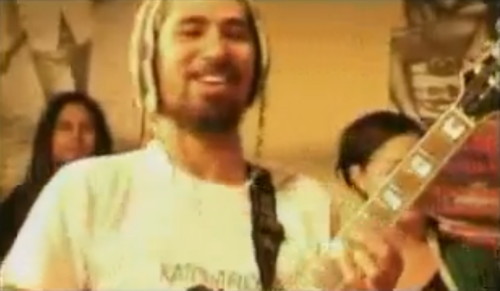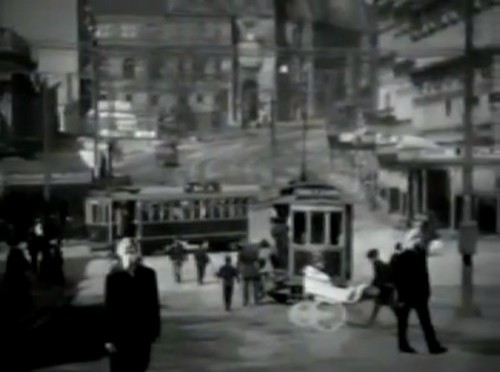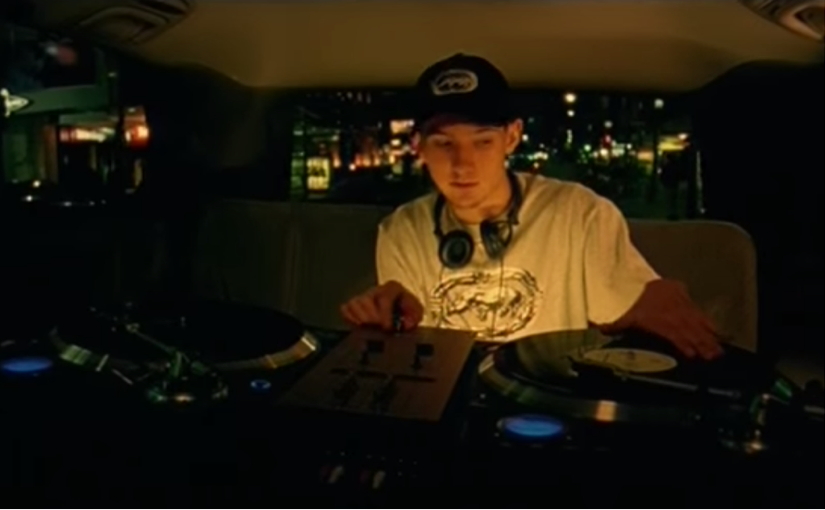Tropical crime fighting, police brutality, high street thugs, an interrogation and love (not war).
Continue reading Found videos from the 2000s
Category: June 2002
Salmonella Dub “Problems”
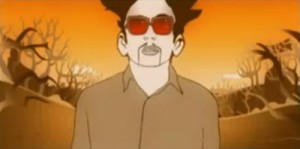 I like a good animated video and this one works really well. It’s a good looking video and it tells a story.
I like a good animated video and this one works really well. It’s a good looking video and it tells a story.
We meet the hero of the story waking up in the desert. He’s just survived a plane crash and discovers a briefcase full of money. Not that it will do him much good when he’s alone in a hot, barren landscape.
He thinks he spies a lush, wet oasis, but, yes, it turns out to be a mirage, complete with an ominous skeleton hanging from a dead tree. This sparks off a hallucination where he plays skulls like a glockenspiel, but he comes back to reality and trudges on. It reminds me a bit of the Sola Rosa video for “Don’t Leave Home”, another slightly surreal desert adventure, only it’s from the skeleton’s perspective.
Eventually the traveller comes across a detention camp, so he carefully removes his fake moustache and replaces it with a “summer moustache” which looks exactly the same as the previous one (a winter moustache?).
A tank rumbles past, but there doesn’t seem to be any sign of the detention camp. Instead he ends up in a place with giant Easter Island-like statues, where upon it rains. The waters rise fast and high, sweeping him away and scattering his money to the tides. Is this the end of our antihero? No, he wakes up on a pleasant beach, being pecked by a pukeko.
The video was directed by James Littlemore and Steve Scott and it looks so good. Many of Salmonella Dub’s videos had a low-budget look to them, like the sort of thing that was quickly filmed in the middle of a tour. But this one feels like a lot of time and effort has gone into it. And as a result, it’s simple, clear and very stylish video.
Best bit: the hallucinated skull solo, where the higher floating skulls make higher notes.
Directors: James Littlemore, Steve Scott
Ngā Taonga Sound & Vision
Next… f’n oats.
Rubicon “Drive”
![]() We’re jumping forward in time to 2005 for this video, as it’s another case of funding being held over until a later time. Rubicon originally received funding in 2002 for their song “All or Nothing”, another track from their debut album. But that video wasn’t made and they ended up going with a couple of other tracks for their final two videos from “Primary”. In 2004 Gene and Jon left the band, and Paul moved to LA and reformed the band with some American musicians. They released the album “The Way It Was Meant To Be”, and their first single “Drive” was allocated the funding previously given to “All or Nothing”.
We’re jumping forward in time to 2005 for this video, as it’s another case of funding being held over until a later time. Rubicon originally received funding in 2002 for their song “All or Nothing”, another track from their debut album. But that video wasn’t made and they ended up going with a couple of other tracks for their final two videos from “Primary”. In 2004 Gene and Jon left the band, and Paul moved to LA and reformed the band with some American musicians. They released the album “The Way It Was Meant To Be”, and their first single “Drive” was allocated the funding previously given to “All or Nothing”.
Ok. So, Rubicon mark II is more of a serious punk-pop band with less of the crazy antics of “Primary” era Rubicon. And a result, the song is pretty generic, as is the video.
It sees Rubicon II playing in a cool warehouse apartment type space with a halfpipe in the background. Rad skater dudes skate back and forth as the band play. The skaters are just there as an accessory, something to make the band look cool. Contrast that with Spike Jonze’s “100%” video for Sonic Youth.
But the video doesn’t get too caught up in trying to be cool. There’s a subplot of sorts involving sock puppets. Hanging out in front of graffiti-strewn school lockers, the puppets seem to be having a cotton-lycra “90210” experience.
I’m not sure why, but the sock puppets seem more likeable than the band. The band seem very serious and full of tension, but the sock puppets are just regular teens, trying to figure out the fraught world of love.
By the way, look out for the appearance of the graffiti-style version of the NZ On Air logo.
Best bit: the badboy sock puppet’s cigarette, which is a fire hazard.
Director: Casey Anderson
Ngā Taonga Sound & Vision
Next… mo’ money, mo’ problems.
Nesian Mystik “For the People”
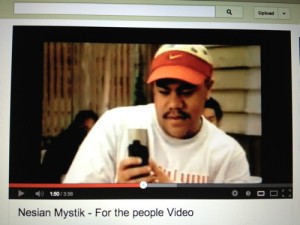
The concept of the video sees Nesian Mystik preparing for a big party. In getting ready for the party, they keep coming across a whole lot of interesting things around Auckland to take photos of, to then send to their friends. There’s Awa stocking up on corned beef and bread, getting a pixt outside the dairy of a cute kid singing.
It becomes like a game of tag. Someone receives a pixt, they take another one and sent it on to someone else. And it’s not just cellphones – the pixts can come in on a home computer too. Most importantly, whenever one of the group gets a pixt, he looks at it and smiles. See, pixts bring joy. Regular reader Vicki remembers these early days of pixts. She says they cost 40 cents to send and the process was very fiddly – it even looks like the band are having to muck around a bit before the pixt is sent.
It’s interesting to compare the pixts of 2002 with the sort of things people photograph today. While the camera pans across the delicious spread of barbecued party food, no one takes pixts of it. It’s all cute little kids or band members. They’re using their camera phones the way people used to use film camera – with great economy. On the other hand, the song is “For the People” not “For the Corned Beef”.
And there are no selfies. All the things that curmudgeons complain about with digital photography today are absent in this video. Instead it’s nice little fuzzy snaps of people smiling, photos that don’t interfere with real life. Everyone’s at the party, having a good time. No one’s slumped in a corner, deep in a FOMO check of their Twitter or Facebook feeds. No hilarious Snapchat annotations. And no one’s figured out yet that in the future, an entire music video will be able to be shot on a phone camera.
Best bit: the surprise spycam pixt.
Mightyscoop “Stay Awake”
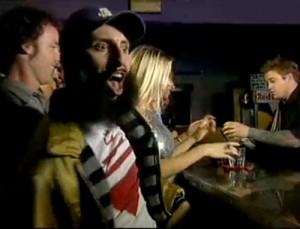 “Are they singing about speed,” wonders YouTube uploader Haurang1. And it’s not hard to come to that conclusion, with both the song and video seemingly about the crazy-arse world of amphetamines. Oh, like a down-under version of “Semi-Charmed Life”.
“Are they singing about speed,” wonders YouTube uploader Haurang1. And it’s not hard to come to that conclusion, with both the song and video seemingly about the crazy-arse world of amphetamines. Oh, like a down-under version of “Semi-Charmed Life”.
The video follows the adventures of “Lars”, a bearded guy who is the group’s roadie. He’s very energetic and spends most of the time hanging out at a bar. Crawling on a pool table, talking the ear off whoever will listen and humping the bar. Ok, so this is a song about speed.
We also see the band playing in a bright white studio, and their performance has the same maniacal energy. Actually, only half the band (the two singer/guitarists) have that energy. The drummer and keyboardist are both sedately playing away in the background, doing what it says on their job description.
The trouble with the video is no one really comes across as very likeable. Lars is a dick and the band seems like some dudes who think they’re far more charming than they actually are. If the song was good, all this would be forgiven, but it’s really ordinary with a boring tacked-on synth line. It all ends up functioning as a cautionary tale against the perils of stimulant abuse.
Best bit: Lars’ thick beard, alarming by even today’s beardiness standards.
Katchafire “Giddy Up”
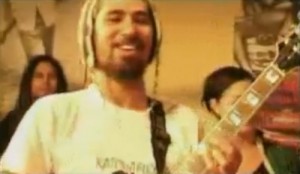 Oh, Katchafire. Previously the only Hamilton bands that had made a national impact were bogan rockers like Knightshade and Blackjack. But along came Katchafire, a roots reggae band who not only had three top-10 singles but had 18 NZ On Air-funded music video. And this is a band who has survived despite line-up changes due to what its Wikipedia entry describes as “commitments with other bands, family and religion”.
Oh, Katchafire. Previously the only Hamilton bands that had made a national impact were bogan rockers like Knightshade and Blackjack. But along came Katchafire, a roots reggae band who not only had three top-10 singles but had 18 NZ On Air-funded music video. And this is a band who has survived despite line-up changes due to what its Wikipedia entry describes as “commitments with other bands, family and religion”.
The “Giddy Up” video begins with a manifesto of sorts. They are here to bring messages of “peace and love and purity”. And that’s musical purity. “We got no DJs, no samplers. We just got some pure musicians on stage, people.” Are they talking about technology – if so, why do they not have an issue with using electric amplification? Or is it some sort of moral purity of the musicians themselves? If so, dicks.
Combined with visuals of bikers arriving at a concert, it all comes across as macho posturing. So then it’s a big surprise when the song itself starts and it’s a sweet, romantic reggae number.
There’s a bit of Katachafire performing at this concert of purity, but most of it is the band playing in a smaller room, surrounded by friends. And that comes across as a lot more enjoyable and friendly.
The song is also notable for its saxophone solo. These were a staple of pop in the ’90s, but had well died out by the ’90s. It’s like Katchafire had a saxophonist and they wanted to put a sax solo in the video and cool kids be damned. And, well, the song made it to number four in the charts.
That’s where the strength of this video seems to lie. Katchafire have this song that people love and they have their band identity and they’re absolutely sticking to that, keeping it pure. Whatever their definition of purity is.
Best bit: the giant Bob Marley poster looking down over them all.
Director: Greg Riwai
Ngā Taonga Sound & Vision
Gramsci “This Ain’t a Love Song”
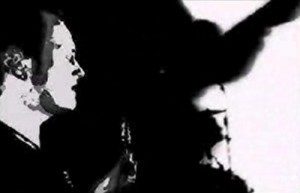 “This ain’t a love song,” snarls Paul from Gramsci, and indeed this ain’t a love song music video. It’s stark and monochromatic black figures on a white background, as the band play the song, slowed down to give it a dreamy feeling. Or as the description on MySpace helpfully explains, “drifty floaty black and white silhouettes overlaid intermingly splace”. Ok.
“This ain’t a love song,” snarls Paul from Gramsci, and indeed this ain’t a love song music video. It’s stark and monochromatic black figures on a white background, as the band play the song, slowed down to give it a dreamy feeling. Or as the description on MySpace helpfully explains, “drifty floaty black and white silhouettes overlaid intermingly splace”. Ok.
The video begins with a band member rolling a cigarette and lighting up, and we see him smoking it throughout. While cigarettes in music videos were a fairly common thing in the ’90s, by the 2000s it was less common, and the Smoke-free Environments Act amendment wasn’t far off, killing smoking at indoor music venues.
So it got me thinking. What if “This Ain’t a Love Song” is about giving up tobacco? What if it’s a bittersweet kiss-off to the difficult life of smoking. And it kind of fits, there with both the song and video casually passing as a typical relationship song.
The video finishes with the cigarette being stubbed out, and the guy who does it seems really relieved, like he’s stubbing out all the drama and emotion contained in the song. Well, that’s my theory. Because if it’s only a song and a video about a relationship, it’s kinda dull.
Best bit: the look of intense concentration when rolling the ciggie.
Note: This video was previously available on MySpace, but not anymore.
Next… an equine command.
Ben King “No Ordinary Day”
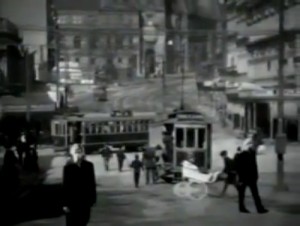 Ben King was otherwise known as the guitarist in Goldenhorse, but he had some songs that he needed to get out there, so he went off on a little side project which resulted in a self-titled solo album.
Ben King was otherwise known as the guitarist in Goldenhorse, but he had some songs that he needed to get out there, so he went off on a little side project which resulted in a self-titled solo album.
“No Ordinary Day” was the single, a sweet pop song, but this wasn’t its original music video. The first version featured Ben jumping on a trampoline. (You can see excerpts of it in this Nightline interview.) Up and down and up and down. It joined Pavement’s original “Rattled by the Rush” video on the list of music videos that can cause motion sickness. So it’s not surprising that the NZOA-funded version is a lot more relaxed and still.
“No Ordinary Day” superimposes Ben on vintage photos of Auckland. So there he is, in black and white, wandering across Wellesley Street with a pedestrians casually in the middle of the road and trams rolling along their route, motorcars nowhere to be seen. The only recognisible building is the Auckland Art Gallery, back when it also housed the city library and municipal offices. Even the familiar Civic theatre corner is yet to acquire its landmark.
Ben is the only thing that moves in these scenes, as if he’s discovered the secret of time travel, but can only ever explore a fixed moment in time. Like a rubbish Doctor Who episode.
The idea of Ben King wandering around old photos never seems to go anywhere. There doesn’t seem to be any point to it, other than it being provided as an example of something that can happen on a day that is not ordinary.
It seems like so much effort has been put into making a video that doesn’t move around all the time, that the end result is a video that doesn’t really go anywhere.
Best bit: the baby’s pram in mid-push across Wellesley Street.
Director: Marek Sumich
Ngā Taonga Sound & Vision
Next… the story of a rollie.
Missing videos from 2002
February 2002
Tadpole “Now Today Forever”
The lone missing video for the February funding round is “Now Today Forever”, the second single from Tadpole’s second album, and a rather driving rock number.
April 2002
Che Fu “Top Floor”
There’s also only one video missing from April, Che Fu’s uplifting number “Top Floor”. As it happens, I wrote a summary of this video in 2002. It sounds amazing:
Che Fu and his posse are hanging out on the front porch of a large wooden lodge. A young lady hands out pieces of chocolate cake and MC OJ and the Rhythm Slave pass out cups of instant coffee. With a very laid-back vibe, Che Fu spends most of the video sitting in a rocking chair, knitting. But just in case you think he’s turning into an old gran, in the middle of a song he turns into a robot and does a rap. But then it’s back to the porch. At the end of the song he’s finished knitting. He admires the, er, long red thing he’s made, tosses the ball of wool up in the air and it magically transforms into a snow ball and then Che’s snowboarding off into the sunset.
June 2002
Fast Crew “Mr Radio”
Along came the Fast Crew, which included Kid Deft who later reverted to his maiden name, Dane Rumble. “Mr Radio” was their debut single, a rant about the difficulty of getting play-listed – something that would soon cease to be a problem for the Crew. The single reached #15 on the Independent NZ chart.
Director: Greg Riwai
Ngā Taonga Sound & Vision
Fuce “Restless”
Christchurch band Fuce have their final NZOA-funded video “Restless”. The group had plans to relocate to Auckland in 2003, but I don’t know what (if anything) happened next.
In 2002 I wrote this about the “Restless” video: This video uses two visual clichés, one old, one getting old. The first is where the camera jerks about as if it’s trying to find something to focus on. The second is when the camera moves as if the power of the music is making the camera shake. Yeah, it’s a low-budget NzonAir video, but it’s looking ok. It just could have looked better if it had just shown the band playing the song, instead of all the dumb camera tricks.
Director: Aaron Hogg
Nga Taonga Sound & Vision
Splitter “You’re Right To Rock”
Splitter got in on the rock ‘n’ roll revival with “You’re Right To Rock” an ode to you-know-what. Sample lyrics: “Power chords are ringing like a bell!”. Aw yeah.
Subware “Into”
Subware’s final funded video was the lush “Into”, with vocals from Sandy Mills.
Theo Va’a “Little Angel”
Theo Va’a was an 10-year-old singer (dancer, entertainer, songwriter and professional model) from Palmerston North who later wowed the 2003 Christmas in the Park crowd. “Little Angel” featured Atilla Va’a, who I assume grew up to be the 130kg rugby prop asserting himself here.
August 2002
Mace & The Woodcut Crew “Shake ‘m”
“Shake ‘m” is a collaboration between rapper Mace and Auckland producers the Woodcut Crew producers. I’m going to assume it’s an instructional song about making protein shakes.
Pluto “Perfectly Evil”
Pluto have the dark and synthy “Perfectly Evil”. It’s been entertainingly used as the soundtrack for an almost wordless short film made by some year 13 students for their media studies assignment.
Director: Wade Shotter
Ngā Taonga Sound & Vision
October 2002
Lavina Williams featuring Emily Williams “Higher Lovin'”
Ex-Ma-V-Elle singer Lavina Williams teams up with her younger sister (and future Australian Idol star) Emily for the soul jam “Higher Lovin'”. Their sisterly harmonies sound fabulous.
December 2002
Crystal Fitisemanu “Sunny Summer’s Day”
I’m not sure if the video for Crystal Fitisemanu’s song “Sunny Summer’s Day” was made. There’s no mention of it online, but there is a brief mention of a $3000 grant in 2001 from Creative New Zealand for Crystal to record five songs.
P-Money featuring 4 Corners “The Xpedition”
“The Xpedition” is another track from P-Money’s debut album, this time featuring 4 Corners on vocals.
Rhombus “Tour Of Outer Space”
Well, Rhombus go on a “Tour of Outer Space”.
Director: Wade Shotter
Ngā Taonga Sound & Vision
Tadpole “Always Be Mine”
“Always Be Mine” was the penultimate single released off Tadpole’s second album.
Instead…
This month’s consolation video is “Verbally Decapitating” by DJ Logikal. It was the winner of a competition that TVNZ’s after-hours music show M2 held, with the prize being a $10,000 fancy music video made for the winning track. This is a throw-back to how things were in the days before NZOA, where TVNZ (and its predecessors) made music videos for bands. Though in this case, it was a heavily promoted contest with an alcohol sponsor. The video – which is a really is a proper fancy video – sees DJ Logikal infecting downtown Auckland with his scratched-up beats, and it features pre-development Britomart for some gritty urban decay. It visually name-checks P-Money, and incorporates the song’s samples by having people on the street lip-syncing the words. The video rightly won Best Editor for James Anderson at the 2003 Kodak Music Clip Awards.
Director: James Anderson
Ngā Taonga Sound & Vision
